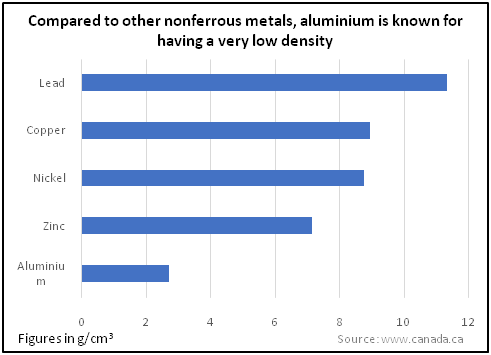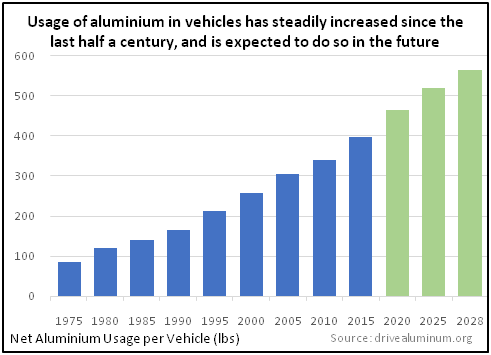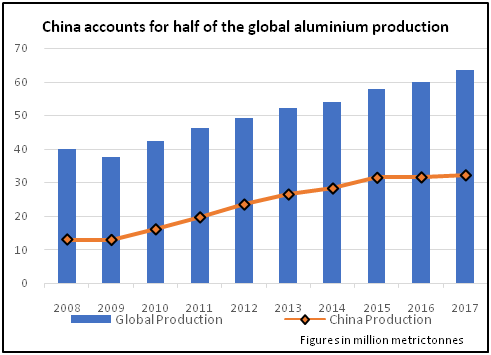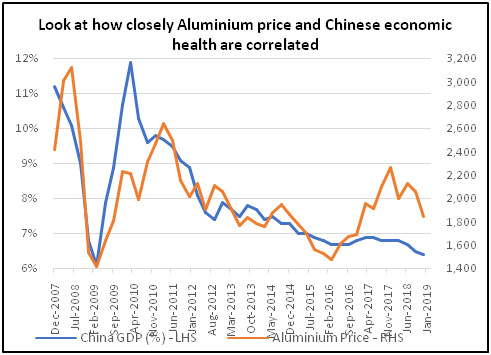
 Aluminium is the most widely used nonferrous metal in the world, with its annual production exceeding that of any of its other nonferrous counterparts. In terms of consumption volume, aluminium ranks number two, only being surpassed by steel. Aluminium is known for having a low density, meaning it is very light in weight and hence easy to move. That said, despite having a low density, aluminium is a very strong metal, is easy to shape, can handle high amounts of stress very well, and can resist corrosion. Because of all these properties, aluminium is the preferred choice of metal for a wide range of activities such as manufacturing, construction, transportation etc. To improve its properties, pure aluminium is often alloyed with other metals, such as zinc, copper, iron, manganese, silicon etc. The aluminium mixture can contain anywhere between 85-99% aluminium and 1-15% other metals.
Aluminium is the most widely used nonferrous metal in the world, with its annual production exceeding that of any of its other nonferrous counterparts. In terms of consumption volume, aluminium ranks number two, only being surpassed by steel. Aluminium is known for having a low density, meaning it is very light in weight and hence easy to move. That said, despite having a low density, aluminium is a very strong metal, is easy to shape, can handle high amounts of stress very well, and can resist corrosion. Because of all these properties, aluminium is the preferred choice of metal for a wide range of activities such as manufacturing, construction, transportation etc. To improve its properties, pure aluminium is often alloyed with other metals, such as zinc, copper, iron, manganese, silicon etc. The aluminium mixture can contain anywhere between 85-99% aluminium and 1-15% other metals.
Aluminium derivatives are traded on the LME. In fact, aluminium is one of the most traded and one of the most liquid commodities on the LME platform. Besides the LME, the other major exchanges where aluminium is traded is COMEX in the US and SHFE in China. In India, aluminium futures is traded on the MCX.
Aluminium usage
 Aluminium is an extremely versatile metal. As already stated, it is known for having a low density, is easy to shape, can handle high amounts of stress very well, can resist corrosion, and can be mixed with other metals to strengthen its properties. Because of all these factors, aluminium is heavily used for a range of activities across industries and sectors.
Aluminium is an extremely versatile metal. As already stated, it is known for having a low density, is easy to shape, can handle high amounts of stress very well, can resist corrosion, and can be mixed with other metals to strengthen its properties. Because of all these factors, aluminium is heavily used for a range of activities across industries and sectors.
The highest demand for aluminium comes from the building and the construction sector, occupying a share of roughly a third of the global demand. Be it a small house or a large skyscraper, aluminium and its alloys are extensively used in every building structure around the world. In fact, after steel, aluminium is the second most used metal in buildings. Within buildings, aluminium is extensively used in window and door panels, building exteriors, roofing, wiring, weight-bearing structures etc. Aluminium is an essential part of all skyscrapers in the world. In fact, it is the material of choice among skyscrapers. This is because aluminium is corrosion resistant, weather-proof, can handle environmental stress very well, and can help to lower energy consumption. Moreover, despite being a very strong metal, aluminium weighs up to 65% less than steel, thereby offering an excellent strength-to-weight ratio. All these factors over the years have caused aluminium’s share in building and construction sector to head north.
 The next major source of aluminium demand is the transportation sector, occupying a share of just less than 30% of the world demand. Aluminium, especially when alloyed, is an extremely strong metal while at the same time is light in weight, weighing just a third of steel and copper. Because of these features, aluminium is the preferred choice of metal in the transportation sector. As aluminium offers the same amount of safety, durability, and sustainability as that offered by other metals but weighs less than the others, its usage helps automakers to reduce the weight of a vehicle without compromising on its other features such as safety. This in turn enables automakers to not only lower costs but also make a vehicle more fuel efficient and therefore adhere to the ever-tightening environmental norms. Meanwhile, aluminium is also the preferred choice of metal in aircrafts and helicopters. It is estimated that aluminium-based alloys comprise nearly 80% of the materials used in a modern aircraft. The objective of using aluminium-based alloys is again to lower weight of the aircraft in order to ensure smooth take-off & flying and offer the same amount of safety.
The next major source of aluminium demand is the transportation sector, occupying a share of just less than 30% of the world demand. Aluminium, especially when alloyed, is an extremely strong metal while at the same time is light in weight, weighing just a third of steel and copper. Because of these features, aluminium is the preferred choice of metal in the transportation sector. As aluminium offers the same amount of safety, durability, and sustainability as that offered by other metals but weighs less than the others, its usage helps automakers to reduce the weight of a vehicle without compromising on its other features such as safety. This in turn enables automakers to not only lower costs but also make a vehicle more fuel efficient and therefore adhere to the ever-tightening environmental norms. Meanwhile, aluminium is also the preferred choice of metal in aircrafts and helicopters. It is estimated that aluminium-based alloys comprise nearly 80% of the materials used in a modern aircraft. The objective of using aluminium-based alloys is again to lower weight of the aircraft in order to ensure smooth take-off & flying and offer the same amount of safety.
Aluminium is heavily used in the electrical sector too, in which it occupies a share of just over a sixth of the global demand. Given that aluminium weighs and costs less than other metals, it is being increasingly used for wiring. In fact, given these advantages, aluminium has started to substitute copper in the power segment. Aluminium is now becoming a preferred choice of metal in utility grids worldwide. With aluminium not only weighing and costing a third of copper but also offering greater conductivity per pound of metal over copper, the relative demand for aluminium from the electrical sector has been forecasted to increase in the years ahead. Besides being used in utility grids, aluminium also finds its usage in wiring residences and buildings, auto segment, electronic appliances etc.
Other areas where aluminium is used include machinery, consumer durables, and packaging. Given its unique properties, aluminium forms an essential component of almost all machinery and equipments that are used in industries. Consumer products that are used at home such as kitchenware, electronic products etc. contain aluminium in rolled form. Meanwhile, an area that is worth mentioning is the usage of aluminium in packaging and cans. Besides the unique properties that we talked about earlier, aluminium also acts as a barrier to light, moisture, oxygen, and bacteria. This makes aluminium foils and cans the preferred economical choice of material for packaging various foods and beverages.
Factors that impact the price of aluminium
Given the diverse usage of aluminium for a wide range of purposes, the metal is impacted by a multitude of factors. Some of the factors that impact the price of aluminium are the same as those that impact the price of copper. These include US monetary policy and the US dollar, LME inventories, and market risk appetite. Given that we have already discussed these factors in the previous session, we won’t be talking about it again. Besides these, the major factors that drive the price of aluminium are mentioned below:
Demand from China
China is the world’s largest consumer of aluminium, accounting for half of the global demand every year. Given the widespread usage of aluminium in the construction and infrastructure sector, the economic health of China plays a crucial role in determining the price trajectory of aluminium. Generally, the robust the Chinese economy, the stronger the aluminium price, and vice versa. The reason why this is so is because globally, around 60 million metric tonnes of aluminium are produced each year, of which China consumes over 30 million metric tonnes. Reduction in Chinese consumption would lead to a global supply glut, meaning there would be excess supplies of aluminium in the global market. Unless this excess supply is absorbed by other nations, it would cause aluminium prices to head lower. Similarly, an increase in Chinese consumption would tighten global supplies, meaning there would be a shortage of supply to meet the global demand. This in turn would cause aluminium prices to strengthen. As such, prices of aluminium are closely impacted by the health of the Chinese economy.Notice in the chart how closely aluminium price tends to move with Chinese GDP. Softening of Chinese economy over the past several years has limited the upside potential in aluminium prices.
Chinese production
 Not only is China the world’s largest aluminium consumer, but it is also the world’s largest aluminium producer. The nation accounts for over half of the primary world output of aluminium. Given such a huge share in world production, aluminium prices are also impacted by factors that can affect Chinese output, such as government policies and input costs, etc. For example, the sustained underperformance of Shanghai prices or increasing input costs of aluminium without a corresponding increase in the aluminium price could lower the profit margins of Chinese smelters, which in turn could lead to a reduction in Chinese aluminium production and tighten the markets. Similarly, tightening of environmental norms by the government could have an impact on the production of aluminium, if the norms curb output levels and reduce smelter capacity. All such factors can impact the supply of aluminium from China and correspondingly impact aluminium prices.
Not only is China the world’s largest aluminium consumer, but it is also the world’s largest aluminium producer. The nation accounts for over half of the primary world output of aluminium. Given such a huge share in world production, aluminium prices are also impacted by factors that can affect Chinese output, such as government policies and input costs, etc. For example, the sustained underperformance of Shanghai prices or increasing input costs of aluminium without a corresponding increase in the aluminium price could lower the profit margins of Chinese smelters, which in turn could lead to a reduction in Chinese aluminium production and tighten the markets. Similarly, tightening of environmental norms by the government could have an impact on the production of aluminium, if the norms curb output levels and reduce smelter capacity. All such factors can impact the supply of aluminium from China and correspondingly impact aluminium prices.
Input costs
Aluminium is produced from a raw material called aluminium oxide, also known as alumina. Alumina is a key input cost in the production of aluminium, accounting for around 20-25% of aluminium prices. Movement in the price of alumina can have an impact on aluminium production and on price too. For instance, a rise in the price of alumina relative to the price of aluminium could compress the margins of aluminium producers, which in turn could reduce aluminium output, and vice versa. Also, approximately two tonnes of alumina are needed to produce one ton of aluminium. Any supply-side issues in the alumina market can spill over to the aluminium market too. For instance, supply tightness in the alumina market can reduce the quantity of the raw material that is needed to produce aluminium, which in turn could lift the aluminium prices in the short-term, and vice versa.
Another major input cost in the production of aluminium is electricity. The entire process of smelting aluminium from alumina consumes a lot of electricity. As per UC Rusal, which is one of the world’s largest producer of aluminium and alumina, energy costs account for approximately 35% of aluminium production costs. As such, any changes in the tariffs by energy companies can have a marked impact on the production cost of aluminium, and subsequently on aluminium prices too.
Global economic health
Global economic health also has a strong impact on the demand for aluminium and subsequently on its prices. If the global economy is in good shape and is strengthening, it would boost consumer demand for automobiles, housing, electronics products, food and drink products etc. Furthermore, as consumers spend more, so does the government in terms of developing infrastructure in the country such as roads, bridges, utility grids etc. All these would require aluminium in some form or the other on a large scale. Hence, improving global health boosts demand for aluminium too, and lifts the prices of the metal. Conversely, if the global economy is in a decline, there would be a reduction in consumer spending, which in turn would reduce demand for aluminium and subsequently put downward pressure on prices. As such, the state of the global economy also plays a key role in determining the price of aluminium.
How to trade aluminium
Aluminium prices are impacted by a variety of demand-side and supply-side factors. When trading aluminium, some of the key things to keep a track of are as mentioned below:
-
Monitor LME data regularly in order to identify trends in inventories and to know if they are at an extreme or are reversing.
-
Keep a regular track of developments in the alumina and energy markets, as they form a major portion of the input cost of aluminium.
-
Monitor economic data from China as well as from key developed nations (US, EU, and UK) and key emerging-market nations (India, Russia, Brazil).
-
Some of the key data to keep a track of are housing, GDP, infrastructure, manufacturing, and auto production/sales. Also monitor the central bank and government policies, particularly that of China and the US, to understand whether they are accommodative or tight.
-
Keep a track on movements in global equities and other commodities to understand the prevailing sentiment in the market.
-
Keep a watch on the medium-term and long-term trend of the dollar, given the negative correlation between the two.
-
Compare LME inventories with LME price spreads, as this gives clues as to the prevailing tightness of aluminium in the physical markets.
Next Chapter
Comments & Discussions in
FYERS Community

ravikumar commented on June 25th, 2019 at 11:24 PM
Please tell us more about LME, Where we can get the inventory report of LME.
Shriram commented on January 27th, 2020 at 9:13 PM
Hi Ravikumar, you can find the LME inventory data on LME's website. Alternatively, KitcoMetals also provides daily LME inventory data on its website.
Ritesh Gatak commented on June 25th, 2019 at 11:32 PM
In Indian MCX which is the most traded commodities among metals, Is it Aluminium or Zinc?
tejas commented on July 2nd, 2019 at 10:28 AM
Hi Ritesh, Zinc is more traded than Aluminium.